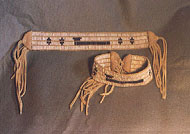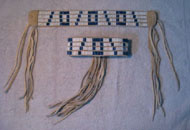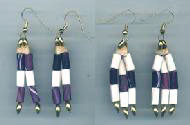
Waaban Aki Crafting ~ Wampum Jewelry and Hand Woven Wampum

I've been creating Museum-Quality Wampum Reproduction work since 1990.
On-line since 1997!
Learn more about the traditions of wampum beads and beadwork on my NativeTech website.
AND JEWELRY | (Click on thumbnails to view a larger image) | ||
| W1
| Woven simulated Wampum Belt Or Bandolier
You may provide your own custom wampum patterns, or I can create a pattern for you with your design ideas. Need help with creating your own unique wampum belt pattern? My realistic wampum belts and bandoliers (shoulder sashes) can measure from anywhere from 1 to over 10 beads wide, and made to custom lengths from less than a foot to several yards long.
Belts that are intended to be worn will have finished ends and long fringe. Please include the measurement around your waist with order or inquiry. Belts meant for display or reproduction will have custom fringed ends by request.
Belts and sashes are common elements among clothing of Native men and women in the 17th century. Breech clouts, mantles, shirts, skirts and coats all used various kinds of belts. In the 17th century Native belts and girdles were worn about the waist and were made of string or cord, or made of leather, belts with beaded designs woven-in or sewn-on, even belts of snake skin for the breech clout. Native women's belts of the Northeast are often longer and wider than the men's equivalent -- worn by a women around her skirt and reaching below her knees. Women's belts may also have been more elaborately decorated with beads or embroidery, owing to European remarks on how beautiful these girdles were, "ornamented with their favourite wampum." Traditionally, wampum belts consist of rows of beads woven together on a simple loom made from a curved stick, which resembles an archer's bow. Weaving would involve stringing the beads onto twisted plant fibers, and securing them to animal sinew or leather thong warp. In the 17th century, inner fibers stripped from milkweed, dogbane, toad flax, velvet leaf, and nettle plants were twisted into fine threads, though imitation sinew is used today. A multitude of Native weaving techniques developed for wampum belts, bracelets, necklaces and collars. Long, wide belts of wampum like these were not produced by Natives until after European contact, but the methods used in making large wampum belts developed from traditional Native techniques of finger-weaving. Some of these belts or bandoliers were extremely wide and long, King Philip's belt or bandolier was nine inches wide "wrought with black and white wampum in various figures and flowers, and pictures of many birds and beasts" which reached to the ground hanging from a man's shoulder. Belt designs might show family relationships or connections among groups. Belts and beads validated treaties and were also used to remember oral tradition. Look through the Archives on WampumBear's pages. (Richard D. Hamell's wonderful resource.) Contact me at
about custom designs and pricing. Include the desired length of the woven piece, and the proposed numbers of rows wide, if you would like a price quote. All my wampum belts and bands are custom made to order using my own hand-made beads, woven onto hand-cut, heavy elkhide thong using imitation sinew. | Price may range from Not Currently Available
| |


| W2 | Woven simulated Wampum Leg Garters - 4 Rows Wide - approx. 14-18 in. long
Leg garters have long fringe in addition to the ties at the back. For an additional fee, add 'deer toe bells' to your garters, as seen in the belt set above! Garters shown are just an example, contact me for custom designs. Include measurement around calf below the knee with order. Many traditional Woodland headbands and bracelet designs in the 1600's used squares, triangles, diagonal lines, crosses, people, animals and other geometric shapes. Just let me know what design elements you would like for your custom piece. | Not currently available |
| W3 | Woven simulated Wampum Arm Bands - 5 Rows Wide - approx. 10-14 in. long
Arm bands have ties, but no fringe at the back. Armbands shown are just an example, contact me for custom designs. Include measurement around biceps with order. | Not currently available | |
| W4 | Finger Woven simulated Wampum Bias Weave Collar, (also called Diagonal Weave) -- 9 rows wide - approx. 40 inches in length.
Long, wide belts of wampum were not produced by Natives until after European contact, but the methods used in making large wampum belts developed from traditional Native techniques of finger-weaving, as with this bias weave collar. These collars lie flat against the chest due to their special diagonal weave.
I've drawn up a basic diagram for bias-weaving instructions with free graph paper.
This one-bead-at-a-time process is quite time consuming!
| Not currently available
| |
| W5-head | Woven simulated Wampum Headband - approx. 18-24 in. long
Bands of beads woven into headbands, belts garters, sashes, Collars, and Bracelets were highly cherished by Native Americans in the 17th century in New England. Early engravings of Delaware show belts, bands, strings, and medallions made of purple and white wampum beads. Woven beadwork is distinguished from strung beads, as the individual beads are delineated into rows of beads placed side by side, rather than end to end as in necklaces, the result being a wide strip of beads usually creating a geometric design. Native Americans in the 1600's "count a rare kinde of decking" the wampum beads woven into bands.
Headbands have long ties at the back. Include measurement around head, just above your ears, with your order.
| One Row Not currently available | |
| W5-hat | Woven simulated Wampum Hatband - approx. 18-24 in. long
Hatbands are woven into one continuous band; there are no ties at the back. Long ties and/or fringe at the back of the hatband can be added by request. Hat not included. Include measurement around your hat's brim with your order. | Same Pricing as Headband above. | |
| W6 | Woven simulated Wampum Choker - approx. 12-16 in. long
Wampum band, woven on soft elk hide warp, to be worn around the neck. For both men's and women's traditional and contemporary wear. As always, let me know if you'd like a pattern different from the one shown here. Include measurement around your neck with your order. | Not currently available | |
| W7 | Woven simulated Wampum Bracelet - approx. 6 in. long
Great for everyday wear, these woven wampum wrist bands come in various sizes and patterns. These bracelets are the perfect accessories for traditional Eastern Woodland regalia. My one-row bracelets also make great awards for Scouting ceremonies.
These patterns are just a few examples. As always, please let me know if have a particular pattern or color preference in mind!
| Not currently available | |
| W8 | Threaded simulated Wampum Necklace
The Iroquois and other Native groups of the Woodlands are known for wampum necklaces like these reproductions. The beads and pendants were hand carved from the marine shells quahog and whelk. Smaller beads were tubes, ovals, barrels, circles, cones, diamonds, triangles, squares, and wavy-edge shaped beads. Larger tube beads and pendants were 2 and 8 centimeters long of animals, turtles, birds, claws, talons, and crescent shapes. Mohawk and Mahican tribes, who obtained shell beads from the coastal New England wampum makers, were major wampum suppliers to the Seneca. Although beads were probably traded as finished products, their arrangement on necklaces varied in different regions.
Please select the style(s) of necklaces you'd like from the labled photo here, or describe the type of necklace you would like custom made.
| Not currently available | |
| W9 | Threaded simulated Wampum Choker - approx. 13 in. long
This threaded choker offers a contemporary 'Plains style' necklace using traditional Woodland style beads. | Not currently available | |

| W10 | simulated Wampum Earring - 2 Bead Strands
These earrings use traditional Northeastern bead and pendant forms. Shell, metal, glass, and other natural materials are traditionally utilized for earrings. In New England as early as 1524, ornaments were traded to the Native Americans: "The things we gave them that they prized the most were little bells, blue crystals, and other trinkets to put in the ear or around the neck". In 1634, Native Americans in New England had ear ornaments of all kinds "wearing pendants in their eares, as formes of birds, beasts, and fishes, carve out of bone, Shells, and Stone." Earrings are made with simulated wampum beads, leather, and brass beads and earwires. Approximately 1 1/2" long.
| Not currently available |
| W11 | simulated Wampum Earring - 3 Bead Strands
Earrings are made with simulated wampum beads, leather, and brass beads and earwires. Approximately 1 1/2" long. | Not currently available | |
| W12 | simulatedWampum Earring - with Bird Pendant
Earrings are made with simulated wampum beads, pendants, leather, and brass beads and earwires. Approximately 2 1/2" long. | Not currently available | |
| W13 | simulated Wampum Earring - Loop Style
Earrings are made with simulated wampum beads, pendants, leather, and brass earwires. Approximately 2" long. | Not currently available |
|
E-mail Address:
Mailing Address: P.O. Box 422 Vernon, CT 06066
© 1997-
Waaban Aki Crafting |
Not Currently Accepting New Orders 
Home Page |